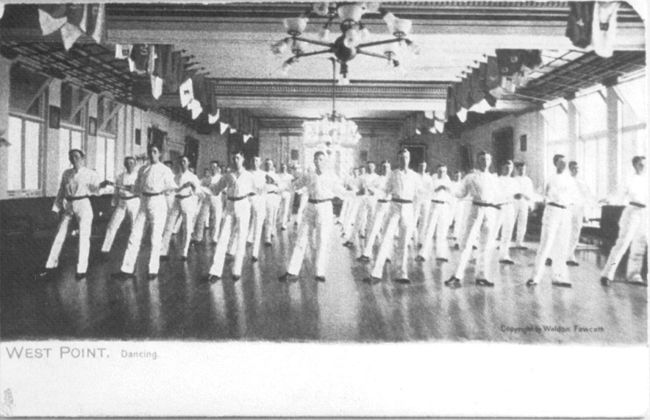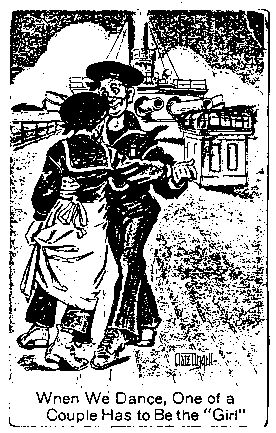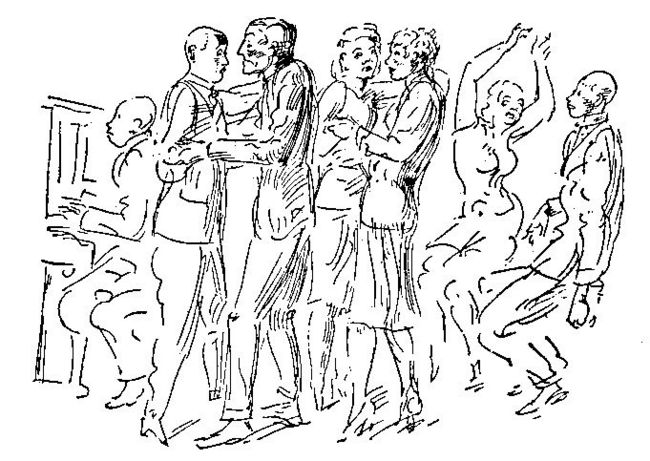Difference between revisions of "U.S. Military Academy at West Point"
| Line 18: | Line 18: | ||
| − | ==Edward Stevenson on Morris Schaff== | + | {{unprotected}} |
| + | |||
| + | ==Edward Stevenson on Morris Schaff at West Point, NY== | ||
According to the early homosexual emancipationist Edward Stevenson, a book, ''The Spirit of Old West Point, 1858-1862'' (Boston: Houghton Mifflin, 1907) | According to the early homosexual emancipationist Edward Stevenson, a book, ''The Spirit of Old West Point, 1858-1862'' (Boston: Houghton Mifflin, 1907) | ||
:presents the military souvenirs of General Morris Schaff, of the United States Army.... In its author's pen-portraits of early friends in the famous Military Academy . . . are to be noted many delicate suggestions of the uranian emotion in young and soldierly comrades. Indeed the accent of a manly similisexualism of psychic quality pervades the record.... Especially in its elegiac passages, it is eloquent of the homosexual thrill in young hearts that beneath uniforms can beat so passionally for each other.<ref>Xavier Mayne (pseud. of Edward Stevenson), ''The Intersexes'' (c. 1908), pp. 209-10. This information first appeared in Katz, ''Gay/Lesbian Almanac'', p. 318. A detailed memoir of Schaff says that he married happily at age 28: see http://penelope.uchicago.edu/Thayer/E/Gazetteer/Places/America/United_States/_Topics/history/_Texts/journals/PrMassHS/64/Morris_Schaff*.html</ref> | :presents the military souvenirs of General Morris Schaff, of the United States Army.... In its author's pen-portraits of early friends in the famous Military Academy . . . are to be noted many delicate suggestions of the uranian emotion in young and soldierly comrades. Indeed the accent of a manly similisexualism of psychic quality pervades the record.... Especially in its elegiac passages, it is eloquent of the homosexual thrill in young hearts that beneath uniforms can beat so passionally for each other.<ref>Xavier Mayne (pseud. of Edward Stevenson), ''The Intersexes'' (c. 1908), pp. 209-10. This information first appeared in Katz, ''Gay/Lesbian Almanac'', p. 318. A detailed memoir of Schaff says that he married happily at age 28: see http://penelope.uchicago.edu/Thayer/E/Gazetteer/Places/America/United_States/_Topics/history/_Texts/journals/PrMassHS/64/Morris_Schaff*.html</ref> | ||
| Line 31: | Line 33: | ||
| − | ==Admiral George Dewey | + | ==Admiral George Dewey at Annapolis, MD== |
| − | ''The Autobiography of Admiral George Dewey'' (N. Y.: Scribner's, 1913, p. 17) refers to a "stag hop. | + | ''The Autobiography of Admiral George Dewey'' (N. Y.: Scribner's, 1913, p. 17) refers to a "stag hop" at the U.S. Military Academy at Annapolis, Maryland.<ref>This information first appeared in Katz, ''Gay/Lesbian Almanac'', p. 318:</ref> |
:In my day at Annapolis we had no system of athletics except our regular military drill. There was no adequate gymnastic apparatus. The rule was one endless grind of acquiring knowledge. Our only amusement within the walls of the academy was the "stag hop" on Saturdays, held in the basementof the old recitation hall. We were all vigorous boys or we could not have passed the physical entrance examination; and we were being trained for a career that required dash and physical spirits. Under such restraint there were bound to be outbreaks and such infractions of discipline as not only would not be tolerated but would not occur to-day. | :In my day at Annapolis we had no system of athletics except our regular military drill. There was no adequate gymnastic apparatus. The rule was one endless grind of acquiring knowledge. Our only amusement within the walls of the academy was the "stag hop" on Saturdays, held in the basementof the old recitation hall. We were all vigorous boys or we could not have passed the physical entrance examination; and we were being trained for a career that required dash and physical spirits. Under such restraint there were bound to be outbreaks and such infractions of discipline as not only would not be tolerated but would not occur to-day. | ||
(OutHistory asks interested researchers to provide additional quotes from and descriptions of the above sources, including page numbers.) | (OutHistory asks interested researchers to provide additional quotes from and descriptions of the above sources, including page numbers.) | ||
| + | |||
| + | |||
| + | ==When We Dance, One of a Couple Has to Be the "Girl"== | ||
| + | [[Image:When We Dance.jpeg]] | ||
| + | |||
| + | World War I, Newport, RI, 1918. Inscription on back: "This is really the way we dance".<ref>Lesbian/Gay History Researchers Network Newsletter, Number 2 (Summer 1980), p. 7. Reproduced in Katz, Gay/Lesbian Almanac, page 517.</ref> | ||
| Line 57: | Line 65: | ||
| − | Truscott, Lucian. ''Dress Gray''. NY: | + | Truscott, Lucian. ''Dress Gray''. NY: <publisher?, date of pub?> |
| + | |||
==References== | ==References== | ||
<references/> | <references/> | ||
| + | |||
<comments /> | <comments /> | ||
Revision as of 17:33, 25 August 2010
A photographic postcard from the early twentieth century (exact date unknown) shows male recruits holding hands as they practice formal dancing with each other. It is captioned: "West Point. Dancing".
Information on the back of this postcard includes:
- Raphael Tuck & Sons' Post Card Series No. 2322, "Life at West Point" Art Publishers To Their Majesties The King and Queen."
A text explains:
- DANCING is a compulsory branch of instruction during two years of the four-year course. "Hops" are held on Saturday evening every two weeks throughout the term, and there are also additional events in the way of dancing graduation week and other periods of special festivity.
Here, in this evidence from English and American popular culture of the early 1900s, formal male-male dancing at the U.S. Military Academy at West Point was publicized as an innocent, if quaint custom. By the 1930s, at least, such physical contact between males, and such ambiguity of role, would become suspect, especially in those sexually segregated military training institution designed to produce "men" and fighters.[1]
Edward Stevenson on Morris Schaff at West Point, NY
According to the early homosexual emancipationist Edward Stevenson, a book, The Spirit of Old West Point, 1858-1862 (Boston: Houghton Mifflin, 1907)
- presents the military souvenirs of General Morris Schaff, of the United States Army.... In its author's pen-portraits of early friends in the famous Military Academy . . . are to be noted many delicate suggestions of the uranian emotion in young and soldierly comrades. Indeed the accent of a manly similisexualism of psychic quality pervades the record.... Especially in its elegiac passages, it is eloquent of the homosexual thrill in young hearts that beneath uniforms can beat so passionally for each other.[2]
One such elegiac passage from page 192 of Schaff's book, recalls male-male dancing at West Point:
- During the release from quarters, when the recitations of the day ended, some would take a stroll around Flirtation Walk . . . — how I should love to ramble along it once more! — a few would go over to the inspiriting silence of the library; a small number, poor victims of athletics, would wrestle with parallel bars, etc., in the gymnasium; but the larger number would congregate in the fencinghall and dance to music by members of the band. How often I sat with Comly — for dancing was not among our accomplishments — and watched the mazing couples, Rosser and Pelham, "Cam" Emory and Ames, Chambliss and Hoxton, Kent and Beaumont, Haines and Cushing, Dearing and Gillespie, Dupont and Farquhar, and many, many others! Yes, that was the way we were passing the time in that January of 1861, on the verge of the Civil War.
Page 183 of Schaff's book includes this passage: "And as the coffin passes the flagstaff I can see the stars and stripes dipping instinctively in memory of the love of two cadets whose West Point friendship the bitterness of war could not destroy."[3]
Admiral George Dewey at Annapolis, MD
The Autobiography of Admiral George Dewey (N. Y.: Scribner's, 1913, p. 17) refers to a "stag hop" at the U.S. Military Academy at Annapolis, Maryland.[4]
- In my day at Annapolis we had no system of athletics except our regular military drill. There was no adequate gymnastic apparatus. The rule was one endless grind of acquiring knowledge. Our only amusement within the walls of the academy was the "stag hop" on Saturdays, held in the basementof the old recitation hall. We were all vigorous boys or we could not have passed the physical entrance examination; and we were being trained for a career that required dash and physical spirits. Under such restraint there were bound to be outbreaks and such infractions of discipline as not only would not be tolerated but would not occur to-day.
(OutHistory asks interested researchers to provide additional quotes from and descriptions of the above sources, including page numbers.)
When We Dance, One of a Couple Has to Be the "Girl"
World War I, Newport, RI, 1918. Inscription on back: "This is really the way we dance".[5]
Changes in the Meaning of Same-Sex Dancing
By 1946, an image presented men dancing with men (and women dancing with women) as what was called "sexual perversion".
John Dos Passos' novel, The Big Money, first published in 1936, includes a scene in which a white woman and man on a date go to a Harlem night club where each dances with members of their own sex.
A drawing by artist Reginald Marsh (from the 1946 edition of the book) depicts two women and two men dancing together. It marks a historical change in the meaning of same-sex dancing and such images. From a time when they represented, merely, a curious quaint custom, to 1946, when the present sktech depicts, in the novel's context, a contact with explicit homoerotic connotations.[6]
Homosexuality in West Point History: A Bibliography
Dress Gray (1986 TV movie).
Kilgannon, Corey. "At West Point, Hidden Gay Cadets Put in Spotlight." New York Times, August 24, 2010, page A1. See: http://www.nytimes.com/2010/08/25/nyregion/25cadet.html
Truscott, Lucian. Dress Gray. NY: <publisher?, date of pub?>
References
- ↑ Re-edited from Jonathan Ned Katz, Gay/Lesbian Almanac (NY: Harper and Row, 1993), p. 318).
- ↑ Xavier Mayne (pseud. of Edward Stevenson), The Intersexes (c. 1908), pp. 209-10. This information first appeared in Katz, Gay/Lesbian Almanac, p. 318. A detailed memoir of Schaff says that he married happily at age 28: see http://penelope.uchicago.edu/Thayer/E/Gazetteer/Places/America/United_States/_Topics/history/_Texts/journals/PrMassHS/64/Morris_Schaff*.html
- ↑ Schaff's book is available on line via a Google search.
- ↑ This information first appeared in Katz, Gay/Lesbian Almanac, p. 318:
- ↑ Lesbian/Gay History Researchers Network Newsletter, Number 2 (Summer 1980), p. 7. Reproduced in Katz, Gay/Lesbian Almanac, page 517.
- ↑ This information first appeared in Katz, Gay/Lesbian Almanac, p. 524-26.
<comments />


